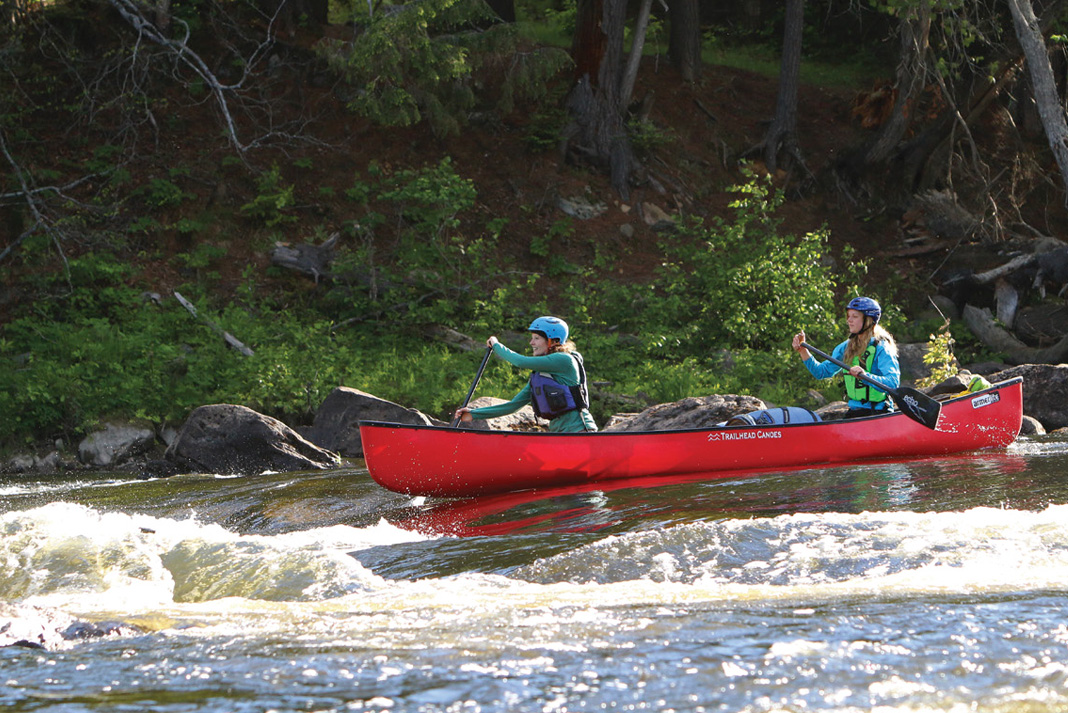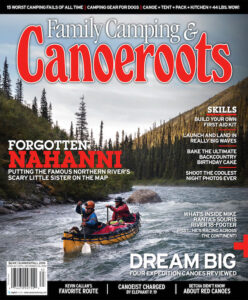Trailhead has a long history of providing the ideal canoe for northern river expeditions. Since 1976, the Ottawa-based retail shop has produced their own canoes, used by tour operators on classic expeditions like the Nahanni, Wind and Coppermine rivers.
Trailhead Canoe Regen 17
LENGTH: 17’
WIDTH: 36”
DEPTH: 14”
WEIGHT: 69 lbs.
MATERIAL: Armerlite
CAPACITY: 1,200 lbs
PRICE: $2,899
LEARN MORE:
trailheadpaddleshack.com
Trailhead released new designs in April 2016 with new designs, debuting new-to-North-America hull material Armerlite. This durable thermal composite has been used in Europe for a decade in canoes as well as rec and whitewater kayaks.
So, what is Armerlite? It’s composed of interwoven glass fiber and polypropylene plastic. The material is layered in a canoe mold, vacuum bagged and cooked in a large oven where the polypropylene and fiber melt together to create a solid bond. The result feels strong and durable. After our testing we have to agree with Trailhead’s claim that Armerlite is an ideal material for wilderness tripping and river running.
To put the material through its paces we chose a handful of shallow and rocky runs for our brand new and fully outfitted 17-foot Regen. The runs were shallow enough that we spent a fair bit of time bumping along, and even had to jump out to line the boat where we ran aground along sections of particularly skinny water.
The hull held up to our abuse. Subtle surface scratches could be found, but few. Our confidence buoyed, we paddled more aggressively on our second outing.
The only time our testers were concerned was while broaching rocks. From the stern, I could see the the hull flex inward. Given the accompanying crackling sound, several times I thought rocks were going to puncture the hull but we always slid over and away. Still, I expected to find real damage. Flipping the boat over on shore, I was astonished— nothing. No marks at all.
Impressive, indeed.
I followed up post-testing with Trailhead Canoe co-owner, Jason Yarrington. “Armerlite will scratch, but the canoe has lots of flex and abrasion resistance because of the polypropylene,” he explains.

Considering Trailhead’s history of providing boats to camps and outfitters, durability is of the utmost importance. “With Armerlite, I’m happy to be selling to that demographic,” adds Yarrington.
Like moths to a flame, the new material caused quite a stir when we found ourselves running the same river as a local paddling club. At the take-out fellow canoeists asked me the question everyone asks nowadays: “What happens when it wraps?”
“We had a rental customer wrap one already this year,” says Yarrington. “The bottom of the hull was intact, but the sides did fold and crack. They had a small amount of leaking but were able to finish the trip.”
Offered in 15-, 16- and 17-foot models, the hull of Trailhead’s new Regen series is based on their traditional Prospector design, however its bow and stern take a more modern shape and don’t feature re-curved stems. Our 17-foot tester features just over two inches of rocker, offering a compromise between good tracking on flats and in-current maneuverability.
Named after the German word for rain, Regen, Germany, is also where the hulls are manufactured. After receiving the raw hulls, Trailhead Canoe adds the trim and outfitting. Ours came river-ready with thigh straps and air bags.
Given the 1,200-pound capacity rating on the Regen 17, it’s become a top contender around the Canoeroots office for multi-week expeditions by staff over the summer.

Subscribe to Paddling Magazine and get 25 years of digital magazine archives including our legacy titles: Rapid, Adventure Kayak and Canoeroots.




